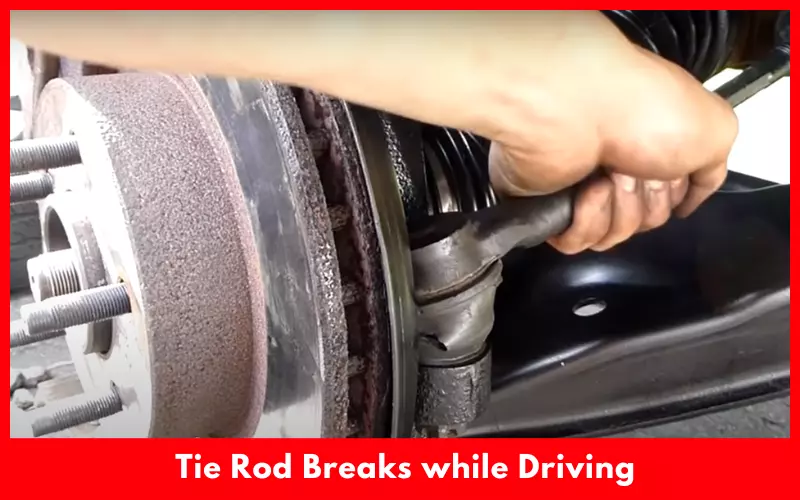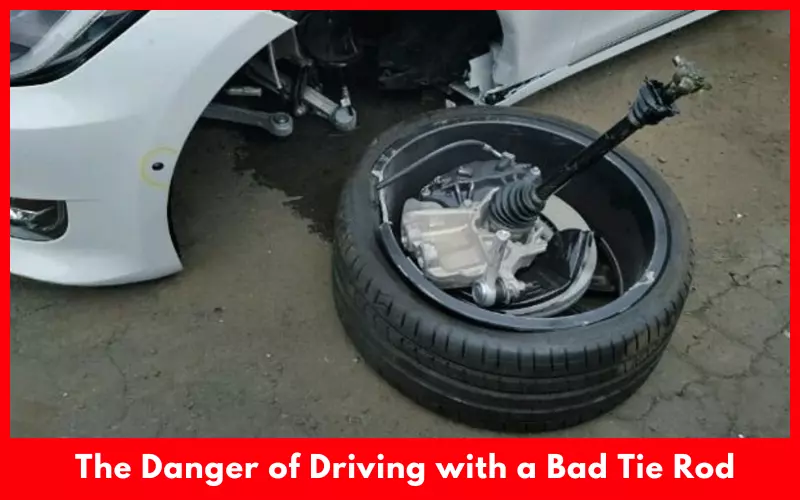Tie rod is an important part of car’s suspension system. You can control your car wheel left and right through tie rod. But how long can you drive on a bad tie rod to decide the next safest steps?
You can’t drive longer than 15 to 20 miles and run the car at high speed with a bad tie rod. If the tie rod is damaged, you won’t be able to turn the vehicle appropriately. The front wheel can come out of the tire if you drive the car over 15 mph speed.
There is also the risk of damaging the expensive components of the car. But you can determine if the tie rod is damaged and solve the problem at home garage cheaply. Let’s discuss briefly.
Article Summary
How does a Tie Rod Work?
Before we determine how long it’s safe to drive with a bad tie rod, it’s important to understand the working principle of the tie rod. This way you can better realize the effect of driving with a bad tie rod.
The tie rod is an essential part of a vehicle. It connects the steering gear to the ball in a socket to allow a car to move on a rough road. Tie rods also help move the side of the tire to side efficiently. Today’s vehicles have an inner tie rod connected to the gear and an outer tie rod connected to the steering wheel control. Both tie rods are adjustable.
Tie rods provide a pivot point between the steering arm, steering wheel, and steering rack. So if they wear out, it’ll be impossible to turn the vehicle precisely.
How Long can you Drive on a Bad Tie Rod?
It usually depends on how loose or bad the tie rod becomes. For example, if the pinch nut on the tie rod is become loose a little bit; the tire will vibrate during driving. Though it’ll be risky to drive, you can still run the car to reach a repair shop. Keep in mind that, you must drive slowly with the loose tie rod.
But, if the tie rod end comes out from the steering knuckle, you won’t be able to turn the vehicle. It won’t be a good decision to keep driving the car with this problem.
Another possibility is worn out. If the tire rod is worn out, it’ll be unsafe to drive the car and it can damage the tire over time. Remember, a tie rod is fairly cheaper than tires and it’s easier to fix as well.
In terms of your query, you can drive your vehicle only for a while and at a maximum of 20 miles and 15 mph speed.
What Happens if a Tie Rod Breaks while Driving?
Tie rods remain alignment to the tires with its adjustment. They maintain the connection between the front tires and steering. When you turn the wheel, the tie rod moves the tire in your desired direction.
But if the tie rods break and you keep driving in this condition, it can cause plenty of consequences. For example, the front wheel can start shaking and cause misaligned, tires can wear out excessively and steering may become imprecise.

A broken tie rod can cause one tire to fall to the side and instant steering loss. Hence, your car can crash particularly if you drive at a fast speed.
It’ll also wear out the car’s tire faster than usual. So you have to replace those tires very sooner. A broken tie rod can cause an accident due to inaccurate steering.
It can also cost you criminal charges if you hurt innocents while driving. So, if you experience any sign of a loose or broken tie rod, hire a qualified mechanic to inspect the vehicle. You can also fix the bad tie issue by yourself using a crescent wrench, a hammer, and a small homemade ramp structure.
Risk of Driving with a Bad Tie Rod

Below are some potential dangers you may face if decide to drive with a bad tie rod:
1. Damage to Components
If the tie rod’s end gets loose, it’ll allow dirt and grimes to enter the joints and links. The debris will then mix in the lubricant and increase the risk of friction. The lubricant can also displace from the links or joints.
The added friction can cause loud noise and excess vibrations. Finally, it can rust the components and reduce the rigidity of the structure.
2. Less Agility
A bad tie rod can cause unresponsive steering. So your car will no longer be maneuverable even if it is in tip-top shape. You’ll also be at risk of causing an accident during driving the car.
3. Less Traction
A car’s tire can wear out unevenly due to a bad tie rod which can cause uneven weight distribution and less traction. So you’ll experience handling issues and be at risk of accidents. It’ll also affect the car’s suspension system and chassis.
How to Determine if a Tie Rod is Bad
Here are some troubleshooting processes to determine if the tie rod is bad:
Jagged Tire Wear
Rough tire wear is an early sign of a bad tie rod. The reason is that broken tie rods disturb the tire’s weight distribution process and cause irregular amounts of contact on the road. It also affects the tire’s alignment negatively.
Clunking Noises and Shaking
The steering wheel’s shaking and vibrating are also symptoms of bad tire rods. You’ll hear clunking noise during driving your car at low speed.
Loss of Steering
It’s a worse sign of a bad tie rod. You’ll feel the steering looser than usual and have to adjust the steering to control the vehicle accurately. It’s a risky sign particularly if you drive the car at high speeds.
Poor Vehicle Alignment
Bad alignment of a car is a common sign of increased tire wear. If so, your car will start shaking and tend to pull one side as well as make the driving fatigue.
How to Fix Bad Tie Rod?
You can easily check your car’s tie rod and determine the actual issue by applying a simple test. Lift your car’s front side off the ground and push the tire. When the tire is moving, carefully check if there is any movement in the joints.

If the tie rod is worn out, you’ll feel the movement. After determining the movement, isolate the cause and find out whether the inner or outer rod has gone bad. Ask your friend to aid in moving the tire while you are inspecting underneath the car.
Sometimes you can determine the problem by sight while sometime you may need to feel. Load the tie rod by pulling it down. If you notice the movement goes away, the inner tie rod goes bad.
Tie Rod Replacement Cost
Before you estimate the repair cost, check the car’s alignment and steering system by yourself or by hiring a professional. Things can happen, you only need to lubricate the system or change the rod bushings instead of replacing the tie rod.

But if you need to change the inner or outer tie rod, you may cost around $200 to $300. Changing the whole steering rack and gearbox can cost you around $500 to $1000 depending on the make and model of the vehicle.
Below is a table of various famous vehicle models along with the approximate cost of replacing the tie rod at repair pal:
| Vehicle Name | Cost of replacing tie rod |
| Chevrolet Silverado 1500 | $137 to $229 |
| Mazda 3 | Around $121 |
| Ford Fusion | $119 to $157 |
| BMW | $618 to $699 |
| Volkswagen Jetta | $204 to $270 |
| Volvo XC90 | $174 to $203 |
| Hyundai Elantra | $119 to $168 |
| Land Rover Range Rover | $223 to $237 |
| jeep wrangler | $395 to $509 |
FAQs
Can a bad tie-rod cause your car to shake?
A bad tie rod can displace the lubrication which can increase friction between components. Hence, your car can start rattling noice and shaking. The shaking can be more obvious when you turn the vehicle at lower speeds.
How long does a tie rod last?
Tie rods are extremely durable and designed to last for several years. You may never need to replace the tie rod if you maintain and drive the car properly. So you can expect to drive up to 50,000 miles comfortably before replacing the tie rod.
Can you replace the bad tie rod yourself?
If you have a skill in an automobile, you can easily replace the tie rod in your home garage. Simply, raise the vehicle, remove the tire, wheel assembly and tie-rod end. Then you can install a new tie rod. Replacing the tie rod doesn’t cost much.
Final Words
After knowing how long can you drive on a bad tie rod, hope you’ll make the best use of that invaluable time. Instead of trying to reach the destination, you should take the car to the nearest auto repair shop.
You can also go back to the home garage if you can fix the issue by yourself. But ignoring those signs can cost you severe accidents or expensive repairs. And it isn’t a smart idea when the tie rod replacement cost is fairly cheaper.

